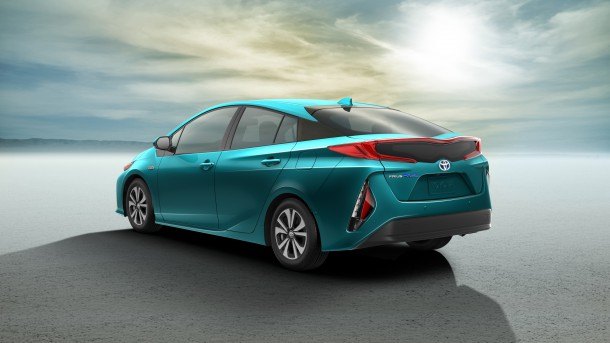NYIAS: 2017 Toyota Prius Prime - Eco-Warrior Goes Posh
In the nearly 20 years it’s been on the market, the Toyota Prius has become an icon of eco-friendly motoring. Now, Toyota wants to build on the legend with a new, more upmarket version called Prius Prime. It comes equipped with plug-in charging, but it should be much more than the previous-generation Prius Plug-In. While the Plug-In was basically nothing more than a basic Prius with a larger battery and electric plug, the Prime is supposed to add style and luxury.
From the outside, it’s still evident that the Prime is built on the same bones as the standard Prius, with identical exterior dimensions and similar basic lines, but the details are noticeably different. The front end is much more aggressive, with a blacked-out “grille” area, segmented headlights and teardrop-shaped running and fog lights in the bumper.
In the rear, the huge taillight forms a shape similar to the one on the current generation Charger. Toyota is eager to point out that the new car is no “aero jellybean.” Instead, the car is said to be “daring the wind to stay in its way.”
Overall, the Prime continues in the aggressive direction set up by the 2016 Prius and takes it one step further. Whether this “muscle hybrid” approach will sit well with the traditional Prius customers remains to be seen.
It’s not all just about looks. The Prime receives a new, 8.8 kWh battery pack. That’s twice the size of its predecessor, doubling the range in fully electric mode to 22 miles. According to Toyota, this should be enough to cover the daily commuting needs of more than a half of U.S. drivers. Recharging the batteries will take 5.5 hours via a standard household outlet, or less than half the time from a 240V plug.
Another difference in comparison with the previous generation, or any other hybrid Toyota for that matter, is that the Prius Prime uses a dual-motor drive system where the generator can be used to provide the driving force as well as the main electric motor. This helps the Prius Prime to achieve more agility in full electric mode, moving its electric top speed to 84 miles per hour, and allows it to spend more time in electric drive, even if driving in standard hybrid mode.
The other part of the Toyota’s Hybrid Synergy Drive is once again a 1.8-liter four-cylinder engine, known from the standard Prius. It’s an Atkinson cycle mill like the standard Prius engine and provides 40-percent thermal efficiency.
The whole drivetrain is said to achieve 120 miles-per-gallon-equivalent in electric mode, whatever that means for real-world consumption. More importantly, the real mpg figures remain the same or slightly better compared with the standard car (54/50 mpg).
Inside, the focal point is the new 11.6-inch infotainment screen with advanced smartphone connection. You can now control the car’s AC from a smartphone, manage its charging schedule, find charging stations, and — of course — compare your eco-driving score with others on social media. The last feature will be undoubtedly loved by everyone driving behind the heroic eco-warriors trying to out-do their Facebook friends.
More by Vojta Dobe
Latest Car Reviews
Read moreLatest Product Reviews
Read moreRecent Comments
- MaintenanceCosts "GLX" with the 2.slow? I'm confused. I thought that during the Mk3 and Mk4 era "GLX" meant the car had a VR6.
- Dr.Nick What about Infiniti? Some of those cars might be interesting, whereas not much at Nissan interest me other than the Z which is probably big bucks.
- Dave Holzman My '08 Civic (stick, 159k on the clock) is my favorite car that I've ever owned. If I had to choose between the current Civic and Corolla, I'd test drive 'em (with stick), and see how they felt. But I'd be approaching this choice partial to the Civic. I would not want any sort of automatic transmission, or the turbo engine.
- Merc190 I would say Civic Si all the way if it still revved to 8300 rpm with no turbo. But nowadays I would pick the Corolla because I think they have a more clear idea on their respective models identity and mission. I also believe Toyota has a higher standard for quality.
- Dave Holzman I think we're mixing up a few things here. I won't swear to it, but I'd be damned surprised if they were putting fire retardant in the seats of any cars from the '50s, or even the '60s. I can't quite conjure up the new car smell of the '57 Chevy my parents bought on October 17th of that year... but I could do so--vividly--until the last five years or so. I loved that scent, and when I smelled it, I could see the snow on Hollis Street in Cambridge Mass, as one or the other parent got ready to drive me to nursery school, and I could remember staring up at the sky on Christmas Eve, 1957, wondering if I might see Santa Claus flying overhead in his sleigh. No, I don't think the fire retardant on the foam in the seats of 21st (and maybe late 20th) century cars has anything to do with new car smell. (That doesn't mean new car small lacked toxicity--it probably had some.)



































Comments
Join the conversation
The new Prius is horrifying in photos, but actually very attractive in person. I dated someone like that once.
When do we get a Prius Sport? Seriously. If Toyota put some effort into making a Prius that autocrossed well and looked a little more sporting, I think they'd sell the crap out of them. I commute just a little more than 22 miles to work and home. I'd be interested.